Armenia (2)
Armenia: ancient kingdom, situated along the river Araxes (modern Aras), the Upper Tigris and the Upper Euphrates.
For the early history of Armenia, see Urartu.
Armenia between Rome and Parthia
From now on, Armenia was one of the battlegrounds between the Romans and the Parthians, an Iranian nation that had replaced the Seleucids in what is now Iraq. Several Roman commanders, like Crassus (53 BCE) and Mark Antony (36) attempted to add Armenia to the Mediterranean Empire to have a bulwark against the Parthians. The latter came close to success: king Artavasdes II submitted to Rome and Armenians fought for Mark Antony at Actium.
As is well-known, Mark Antony and his wife Cleopatra VII Philopator met their end in 30 BCE, and their son Alexander Helios, who was supposed to be king of Armenia, never ascended to the throne. Instead, a son of the Artaxiad king Artavasdes II, Artaxias, became king, only to be replaced by Tigranes III by order of Augustus' general Tiberius in 20 BCE.
| Tigranes III |
|
| Tigranes IV |
|
| Artavasdes |
|
| Ariobarzanes (from Media Atropatene) |
|
| Artavasdes III (from Media Atropatene) |
|
| Tigranes V and Erato |
|
| Interregnum | |
| Artaxias III Zenon (from Pontus) |
|
| Arsaces (from Parthia) |
|
| Mithridates (from Iberia) |
|
| Rhadamistus (from Iberia) |
|
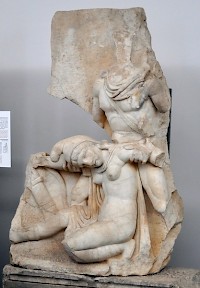
Dynastic quarrels forced Rome to intervene several times. At the beginning of our era, it was Augustus' grandson Gaius Caesar who invaded Armenia. The situation remained chaotic, because both Rome and Parthia tried to gain control of this fertile country. But slowly, consensus was growing that the Euphrates was to be the frontier between the mutual zones of influence. Lesser Armenia, west of the Euphrates, was included in the province of Cappadocia, but Greater Armenia remained independent.
According to a treaty between Augustus and his Parthian colleague Phraates IV, the Romans had the right to appoint the Armenian kings. However, in 52 CE the Parthian king Vologases I, a member of the Arsacid dynasty, using an internal crisis in Armenia and a change of government in Rome, installed his brother Tiridates as king of Armenia. This deliberate provocation led to war, and to the sack of Artaxata in 58 by the Roman commander Corbulo. Tiridates was forced to visit Rome to be crowned again by the emperor Nero. From now on, the king of Parthia was to be an Arsacid, recognized by Rome.
Increasing Roman Influence
Slowly, Rome was increasing its influence, and when Vespasian had added Commagene to the empire, a legionary base was created in Satala, controlling access to Armenia. As a rule, the Romans continued to select a king from a member of the Armenian branch of the Arsacid family. However, the country was briefly occupied by the Roman emperor Trajan between 114 and 117 CE. His successor Hadrian gave up the conquests.
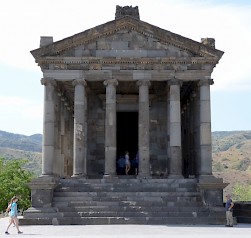
Although our sources mention war, the Hellenistic and early Roman age were usually quiet. Graeco-Roman culture spread (cf. the Roman-style monument in Garni), although other parts of the country looked as if they were still in the Stone Age (e.g., Karahunj).
But quiet though it might have been, in 161-165, the Parthians and Romans went to war again. The Parthians were defeated by the emperor Lucius Verus, and Rome's power increased even more, but Armenia retained its independence, although from now on, it was Rome's loyal ally against Parthia. For instance, when Septimius Severus attacked the Parthian capital Ctesiphon, Armenian soldiers were in his army. They had little alternative, because Severus had added Mesopotamia to the empire, which meant that the main roads between Armenia and the south were now controlled by Rome.
| Tiridates |
|
| Tigranes VI "the Cappadocian" |
|
| Tiridates (restored) |
|
| Axidares |
|
| Parthamasiris |
|
| Sanatruces |
|
| Roman province |
|
| Vologases III |
|
| Pacorus |
|
| Sohaemus |
|
| Vologases V |
|
| "Chosroes" |
|
| Tiridates II |
|
| Chosroes II |
|
| Tiridates III |
|
Armenia between Rome and Persia
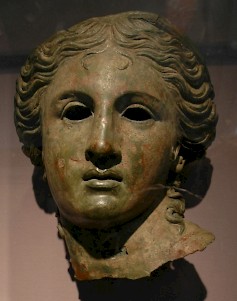
In the second quarter of the third century, the Parthian Empire was replaced by the Persian Empire of the Sasanian dynasty, a more aggressive power than its predecessor. Several times, the Sasanians attempted to add Armenia to their possessions, but they were repulsed by Armenian kings and Roman generals, although often with great difficulty. The situation was restored to Rome's advantage again by the emperor Carus.
Meanwhile, a religious shift was taking place: Christianity was spreading throughout the East. Although the Armenian Church has claimed that it was founded by the apostles Thaddeus and Bartholomew, the first missionaries appear to have visited the country along the Araxes much later.
The breakthrough was in the year 303, when Gregory the Illuminator (257-325) converted the Armenian king Tiridates III. For the first time in history, an entire state became Christian. (The Roman emperors Diocletian and Galerius, who were persecuting the new faith, will not have appreciated this.) Thie conversion is the subject of the History of St. Gregory and the Conversion of Armenia by Agathangelos.The Armenian Church has remained independent and has refused to accept the decisions of the Council of Chalcedon (451).
In the second half of the fourth century, the Sasanian king Shapur II was able push back Rome, and gained influence in Armenia, which was recognized by the Roman emperor Theodosius in 384, when he signed a treaty with Shapur's son Shapur III. In 428, the Romans and Persians divided the ancient kingdom. Its traditions survived in the Armenian Church, which has stressed the country's own independence: for example, the monk Mesrop Mashtots created a special Armenian alphabet, Moses of Chorene wrote a History of Armenia, and there were several independent councils at Dvin.
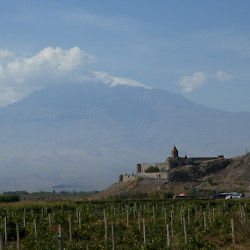 Khor Virap and Ararat |
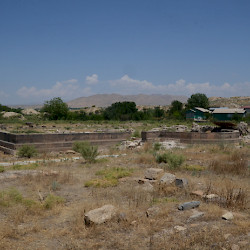 Dvin, Cathedral |
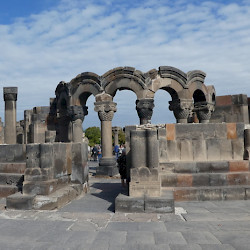 Zvarnots, Cathedral |
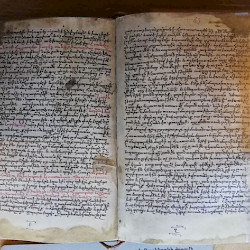 Armenian manuscript with Coptic Refutations of the Decisions of the Council of Chalcedon |